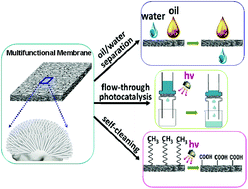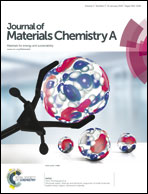Underwater superoleophobic porous membrane based on hierarchical TiO2 nanotubes: multifunctional integration of oil–water separation, flow-through photocatalysis and self-cleaning†
Abstract
Functional porous membranes with special surface wettability have been applied widely for the treatment of water contamination. Herein, we demonstrated a novel underwater superoleophobic porous membrane with multifunctions such as oil–water separation, flow-through photocatalysis and self-cleaning. The porous membrane was fabricated by electrochemical formation of hierarchical TiO2 nanotubes on the surface of porous titanium, followed by calcination in air. Due to its superhydrophilicity and underwater superoleophobicity, the porous membrane achieved the separation of oily substances from water by allowing water to permeate through the membrane. The photocatalysis of hierarchical TiO2 nanotubes in the porous membrane was used to decompose toxic organic molecules during the permeation of polluted water through the membrane. In some cases, when the porous membrane was contaminated by organic molecules in the environment and lost their unique surface wettability, the UV-induced self-cleaning function of hierarchical TiO2 nanotubes recovered its original wettability. This multifunctional porous membrane demonstrated potential application against water contamination.


 Please wait while we load your content...
Please wait while we load your content...